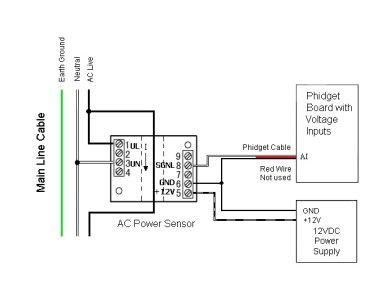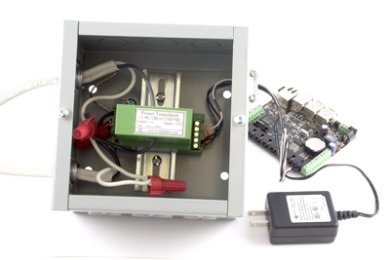This AC Active Power sensor measures AC power up to 7500W. Powered by an external 12VDC power supply, the AC Active Power Sensor provides a 0 to 5VDC analog signal that is linearly proportional to the power measured.
The AC Power Sensor can easily be mounted using the screw holes, or on a 35mm wide DIN rail for quick installation. The terminal blocks accommodate conductors of up to AWG #16. The window in the Sensor has a diameter of 6.5mm.
The current sensor connects to an analog input on Phidgets I/O boards. The formula to translate the SensorValue into Power is:
To determine the offset in your system, record the SensorValue when there is no power applied to the sensor. Use that value in the place of SensorOffset in the formula above.
| Sensor Properties | |
|---|---|
| Sensor Type | Power (AC) |
| Sensor Output Type | Non-Ratiometric |
| Input Frequency | 50 Hz |
| Input Current Min | 0 A |
| Input Current Max | 30 A |
| Input Voltage Min (AC) | 0 V AC |
| Input Voltage Max (AC) | 250 V AC |
| Input Power Min | 0 W |
| Input Power Max | 7.5 kW |
| Measurement Error Max | 0.5 % |
| Sensor Response Time Max | 500 ms |
| Electrical Properties | |
| Supply Voltage Min | 12 V DC |
| Supply Voltage Max | 12 V DC |
| Current Consumption Max | 25 mA |
| Output Voltage Min | 0 V DC |
| Output Voltage Max | 5 V DC |
| Isolation Voltage (AC) | 1.5 kV AC |
| Isolation Voltage (DC) | 2.5 kV DC |
| Physical Properties | |
| Recommended Wire Size | 12 - 24 AWG |
| Wire Window Size | 6.5 mm |
| Operating Temperature Min | 0 °C |
| Operating Temperature Max | 50 °C |
| Customs Information | |
| Canadian HS Export Code | 9030.33.00 |
| American HTS Import Code | 9030.33.38.00 |
| Country of Origin | CN (China) |
You can use the 1144 - 12V Sensor Adapter to connect the voltage sensor to an analog input as pictured below.

Alternatively, you can use the 3002 - Phidget Cable 60cm or the 3004 - Phidget Cable 350cm to connect the AC Power Sensor to your Phidget. Just snip off the connector from one end of the Phidget cable and connect the wires as described below. You can also use a 3031 – Female Pigtail if you don't want to cut the barrel jack off of the power supply.

For boards that have power input, such as the 1019 or the 1073, if the supplied power is 12V, then the + terminal block on the Phidget Board can be connected to the voltage sensor terminal 5 (+12V), and the G terminal block on the Phidget Board can be connected to the sensor terminal 6 (-).
Warning: The AC Power Sensor needs to be attached in parallel with the line voltage. This requires cutting and using loose ends of high power cables. ALWAYS be sure to turn off the power running through the cables while manipulating and before cutting the cables. When attaching the cables, be sure to follow your country’s wiring code to ensure safe installment of the sensors and to reduce the risk of injury and fire. If you are uncomfortable, consult with a certified electrician.
